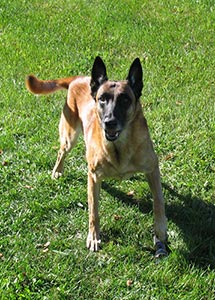Shaping a Find and Bark
For certain applications, a dog shouldn’t touch a found article in any way. A pretty clear example would be an explosives detection dog (EDD), which is obviously trained to do a passive alert— usually a sit. More recently, trainers have used scent detection dogs to identify individuals with varying medical conditions, ranging from skin cancer to low blood sugar. In these cases, too, a passive alert is appropriate.
But there are other applications for a “no touch” indication that don’t require passivity. One such example is an evidence or article search dog. Dogs that specialize in article or evidence search should indicate without disturbing the article or the immediate scene. While a passive alert would be acceptable, it isn’t necessary to freeze in position.
One of the more interesting indications to teach is the find and bark. In this, the dog locates the article but does not touch. Instead, they stand near the article and bark, alerting their handler to a find. Because barking is self-reinforcing, this is an exciting indication for the dog, and they have to learn to hold a “line” near the article that they don’t cross, in order to avoid contamination. It’s not an indication for every dog or handler. It takes a dog that is as fighty as they are operant. It also takes good timing in the handler. The dog is in a highly aroused state, so shaping the right indication while avoiding bursty behavior that may include pawing or biting is vital to the correct finished product.
The first time I saw this kind of an article indication, I got excited. I had a baby puppy that was a scent genius, and something cool to teach. Then reality set in, and I realized that I intended to do schutzhund tracking, where the stand indication would be perfectly OK, but the barking would result in point deductions. So I filed it away for future use.
Recently I decided to give my retired “old lady” a chance to learn a find and bark indication for demonstration purposes. Since she is very fighty, I knew the concept would be easy, but remaining “clean” (just as in the hold and bark of a helper or decoy) would be the challenge. Fortunately, it was easier than I expected because she’s good at sussing out rules when free-shaping.
First I got her excited about the article with a few retrieves. I asked her for a known behavior, bark for the toy (root of the hold and bark in protection). No problem. Next was getting a stand and bark rather than a sit. This was harder than I thought, because the sit and bark was deeply ingrained in her. Waiting her out yielded a barking stand.
Once she understood that standing and barking was OK, I placed the article on the ground. Confused, she started offering her customary down indication. By waiting her out and telling her “wrong,” she finally leapt up and barked at me in frustration. I clicked and threw a treat for her. She immediately offered another standing find and bark, with one paw touching (see photo). In this case, her frustration had led her to put her foot on the article, which is not part of the finished behavior, but was an acceptable start towards it.
The next step was to stand and bark without touching the article. Here she experimented a bit, offering a down and bark, and finally taking a step back from the article with a quiet “woof.” Jackpot! She stayed at this point for awhile, not being certain which part of the behavior I was looking for. It’s hard to tell in the photo of this stage, but she is experimenting with wrinkling her nose rather than barking here (see photo).
The last step was getting that distance from the article with a real bark of conviction. This was easy once she got past the previous step and understood that she wasn’t to touch. Not touching instantly raised the frustration level, and led to serious barks. Mega jackpot! A few repetitions and she was offering some high energy barking at the article, without touching (see photo).
Timeline
Step 1: Stand and bark. Here she’s touching the article, which isn’t part of the finished behavior but shows she understands that she is interacting with the article.
Step 2: Stand without touching the article. This threw her, and she finally offered a step back with the article leg in confusion.
Step 3: Stand without touching the article, barking . Zoom in for a better view of her blurry head and spitty mouth, barking with energy and intent.
Finished Product
With a little more work, she’ll have a finished find and bark that can be added to an area search. At this point there is no command, and the duration she’s capable of barking is roughly 30-45 seconds before she starts looking at me (as seen in the final photo). The barking needs to be extended and the behavior refined before a command goes on (which gives me time to come up with something different from all of her other “find” commands for various scent tasks.)



